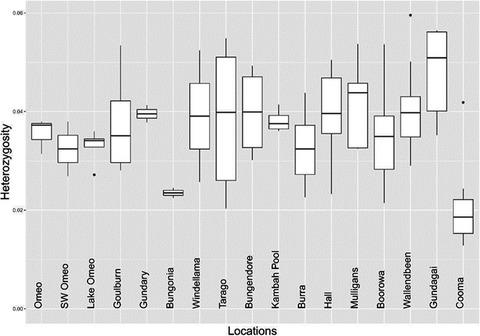当前位置:
X-MOL 学术
›
Ecol. Evol.
›
论文详情
Our official English website, www.x-mol.net, welcomes your
feedback! (Note: you will need to create a separate account there.)
An endangered flightless grasshopper with strong genetic structure maintains population genetic variation despite extensive habitat loss
Ecology and Evolution ( IF 2.3 ) Pub Date : 2021-04-04 , DOI: 10.1002/ece3.7428 Ary A Hoffmann 1 , Vanessa L White 2 , Moshe Jasper 1 , Hiromi Yagui 1 , Steve J Sinclair 3 , Michael R Kearney 2
Ecology and Evolution ( IF 2.3 ) Pub Date : 2021-04-04 , DOI: 10.1002/ece3.7428 Ary A Hoffmann 1 , Vanessa L White 2 , Moshe Jasper 1 , Hiromi Yagui 1 , Steve J Sinclair 3 , Michael R Kearney 2
Affiliation

|
Conservation research is dominated by vertebrate examples but the shorter generation times and high local population sizes of invertebrates may lead to very different management strategies, particularly for species with low movement rates. Here we investigate the genetic structure of an endangered flightless grasshopper, Keyacris scurra, which was used in classical evolutionary studies in the 1960s. It had a wide distribution across New South Wales (NSW) and Victoria in pre-European times but has now become threatened because of land clearing for agriculture and other activities. We revisited remnant sites of K. scurra, with populations now restricted to only one area in Victoria and a few small patches in NSW and the Australian Capital Territory (ACT). Using DArtseq to generate SNP markers as well as mtDNA sequence data, we show that the remaining Victorian populations in an isolated valley are genetically distinct from the NSW populations and that all populations tend to be genetically unique, with large FST values up to 0.8 being detected for the SNP datasets. We also find that, with one notable exception, the NSW/ACT populations separate genetically into previously described chromosomal races (2n = 15 vs. 2n = 17). Isolation by distance was detected across both the SNP and mtDNA datasets, and there was substantial differentiation within chromosomal races. Genetic diversity as measured by heterozygosity was not correlated with the size of remaining habitat where the populations were found, with high variation present in some remnant cemetery sites. However, inbreeding correlated negatively with estimated habitat size at 25–500 m patch radius. These findings emphasize the importance of small habitat areas in conserving genetic variation in such species with low mobility, and they highlight populations suitable for future translocation efforts.
中文翻译:

尽管栖息地广泛丧失,一种具有强大遗传结构的濒临灭绝的不会飞的蚱蜢仍保持种群遗传变异
保护研究主要以脊椎动物为例,但无脊椎动物的世代时间较短和当地种群规模较大可能会导致截然不同的管理策略,特别是对于移动率较低的物种。在这里,我们研究了一种濒临灭绝的不会飞的蚱蜢Keyacris scurra的遗传结构,这种蚱蜢在 20 世纪 60 年代被用于经典进化研究。在前欧洲时代,它广泛分布在新南威尔士州(NSW)和维多利亚州,但现在由于农业和其他活动的土地清理而受到威胁。我们重新考察了K. scurra的残余地点,其种群现在仅限于维多利亚州的一个地区以及新南威尔士州和澳大利亚首都特区 (ACT) 的几小块地区。使用 DArtseq 生成 SNP 标记以及 mtDNA 序列数据,我们表明,一个孤立山谷中剩余的维多利亚种群在遗传上与新南威尔士州种群不同,并且所有种群往往在遗传上是独特的, F ST值高达 0.8检测到 SNP 数据集。我们还发现,除了一个值得注意的例外,新南威尔士州/澳大利亚首都地区人口在遗传上分为先前描述的染色体种族(2 n = 15 与 2 n = 17)。在 SNP 和 mtDNA 数据集中都检测到了距离隔离,并且染色体种族内存在显着差异。通过杂合度测量的遗传多样性与发现种群的剩余栖息地的大小不相关,在一些残余墓地中存在很大的变异。然而,近亲繁殖与 25-500 m 斑块半径的估计栖息地大小呈负相关。 这些发现强调了小型栖息地对于保护此类低流动性物种的遗传变异的重要性,并强调了适合未来易地努力的种群。
更新日期:2021-05-19
中文翻译:

尽管栖息地广泛丧失,一种具有强大遗传结构的濒临灭绝的不会飞的蚱蜢仍保持种群遗传变异
保护研究主要以脊椎动物为例,但无脊椎动物的世代时间较短和当地种群规模较大可能会导致截然不同的管理策略,特别是对于移动率较低的物种。在这里,我们研究了一种濒临灭绝的不会飞的蚱蜢Keyacris scurra的遗传结构,这种蚱蜢在 20 世纪 60 年代被用于经典进化研究。在前欧洲时代,它广泛分布在新南威尔士州(NSW)和维多利亚州,但现在由于农业和其他活动的土地清理而受到威胁。我们重新考察了K. scurra的残余地点,其种群现在仅限于维多利亚州的一个地区以及新南威尔士州和澳大利亚首都特区 (ACT) 的几小块地区。使用 DArtseq 生成 SNP 标记以及 mtDNA 序列数据,我们表明,一个孤立山谷中剩余的维多利亚种群在遗传上与新南威尔士州种群不同,并且所有种群往往在遗传上是独特的, F ST值高达 0.8检测到 SNP 数据集。我们还发现,除了一个值得注意的例外,新南威尔士州/澳大利亚首都地区人口在遗传上分为先前描述的染色体种族(2 n = 15 与 2 n = 17)。在 SNP 和 mtDNA 数据集中都检测到了距离隔离,并且染色体种族内存在显着差异。通过杂合度测量的遗传多样性与发现种群的剩余栖息地的大小不相关,在一些残余墓地中存在很大的变异。然而,近亲繁殖与 25-500 m 斑块半径的估计栖息地大小呈负相关。 这些发现强调了小型栖息地对于保护此类低流动性物种的遗传变异的重要性,并强调了适合未来易地努力的种群。











































 京公网安备 11010802027423号
京公网安备 11010802027423号